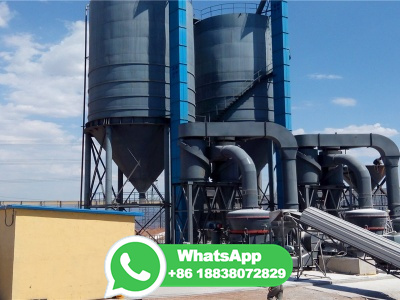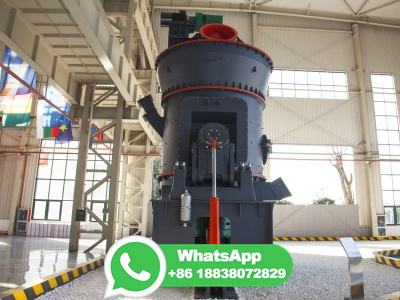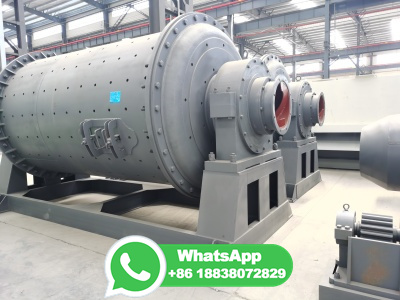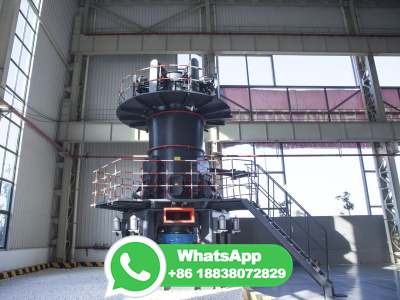
The requirements for the cement industry in the future are to reduce the use of energy in grinding and the emission of CO 2 from ... clay, iron ore), cement clinker and cement additive materials ( limestone, slag, pozzolan) and coal. Multicompartment ball mills are relatively inefficient at size reduction and have high specific energy ...
WhatsApp: +86 18203695377
Coal Mill; Clinker; The first step in the cement process is to extract limestone and clay from the earth. The key elemental components for cement are Ca, Al, Fe and Si. ... ray fluorescence allows cement analysis of major and minor oxides present in the raw materials and products found in the cement industry. A WDXRF spectrometer configured as ...
WhatsApp: +86 18203695377
On an overall basis, VRM consumes about 20 % lower specific energy than conventional closed circuit ball mills and is being widely used for raw material and coal grinding in the cement industry. The adoption of an external raw material recirculation system has further improved the efficiency of VRM.
WhatsApp: +86 18203695377
• Enclosing cement mill section and using rubber curtains as a barriers for dust. • Control the corrosion of different transfer platforms. • Provision of dust suction facility at ground level. 39 • 1. Policy Aspects • A comprehensive norm for cement industry (covering all pollutants, when coal and/or alternate fuels are used.)
WhatsApp: +86 18203695377
section, raw mill section, coal mill section, kiln section and cement mill section. There is also . ... In Cement Industry raw meal blending or homogenization is always done in silos. It is the last
WhatsApp: +86 18203695377
The Indian Cement Industry has been a front runner in adopting state of the art technology, innovative process improvements and resilient business practices. ... Coal Mill Vertical Roller Mill: : Five Stage Preheater Clinkerisation: 17 05: Six+ Stage Preheater Clinkerisation: : Five Stage Preheater Upto Clinkerisation: :
WhatsApp: +86 18203695377
LOESCHE coal grinding mills are distinguished by characteristics that improve efficiency, safety and environmental protection, from the standard version to topoftherange installations. Special versions are available with characteristics that meet special safety regulation or output control requirements. REFERENCES. PLANT SIZES.
WhatsApp: +86 18203695377
We have supplied vertical roller mills (VRM) for raw, coal, slag and cement grinding for several decades. The vertical roller mill is well known in the cement and power plant industries as the preferred mill for grinding of raw materials. ... The cement industry's focus on energy reduction has made vertical roller mills particularly ...
WhatsApp: +86 18203695377
It is a mechanical device used to grind raw coal into pulverized coal powders. The most used coal mills in cement plants are airswept ball mills and vertical roller mills. At present, most cement plants use coal as the main fuel in the clinker production process. The standard coal consumed by the new dry process for producing 1 ton of cement ...
WhatsApp: +86 18203695377
Pareek P, Sankhla VS. Review on vertical roller mill in cement industry and its performance parameters. ... Chelgani SC. Modeling metallurgical responses of coal TriFlo separators by a novel BNN: A "ConsciousLab" development. Int. J. Coal Sci. Technol. 2021; 8 (6):. doi: /s. [Google Scholar]
WhatsApp: +86 18203695377
The coal mill grinding system is an important part of the dry process cement manufacturing. In cement plants, we usually adopt the air swept coal mill system or vertical mill system as the pulverized coal preparation system, which is arranged at the cement kiln head or kiln tail to provide fuel for clinker calcination. However, due to the flammable and explosive characteristics of pulverized ...
WhatsApp: +86 18203695377
A raw mill stoppage is another example of an upset condition handled by ECS/ProcessExpert, whereby gas pressure changes in the speed of the ID and EP fans. Other examples of upset conditions include high preheater exit CO, cooler bed build up and coal mill stoppage affecting the coal feed to the kiln. ECS/ProcessExpert is easily
WhatsApp: +86 18203695377
1 Potential safety hazards in the coal mill system. Spontaneous combustion occurs. The process of cement production determines the need to use a large amount of coal. The use of coal is mostly ...
WhatsApp: +86 18203695377
While total electrical energy consumption for cement production is about 100 kWh/ton of cement, roughly two thirds are used for particle size reduction [2]. About 65% of the total electrical energy used in a cement plant is utilized for the grinding of coal, raw materials and clinker Fig. 1. The cement industry one of the worst pollutant ...
WhatsApp: +86 18203695377
PAT performance of the cement industry. The Bureau of Energy Efficiency's (BEE) Perform, Achieve, Trade (PAT) Cycle I (201215) included 478 units (designated consumers or DCs) from eight energyintensive sectors, including cement. ... heat available after the utilisation of cooler gas in the cement/ raw/coal mills for drying, and the number ...
WhatsApp: +86 18203695377
Airswept coal mill is the main equipment of cement plant, also called coal mill in cement plant, used for grinding and drying various hardness of coal, crushing the coal briquette into pulverized is the important auxiliary equipment of pulverized coal furnace. The airswept coal mill runs reliably, can work continuously, also has a large production capacity and less energy consumption.
WhatsApp: +86 18203695377
Grinding systems in the cement industry play an important role in the distribution of the particle size and particle shape ... Generally on cement mills, the product is ground dry in a ball mill. ... Coal has been the key fuel in the cement industry for a long time. A wide range of other fuels such as gas, oil, liquid waste materials, solid ...
WhatsApp: +86 18203695377
The cement industry consumes around 2% of global primary energy use and produces 57% of anthropogenic CO 2 emissions worldwide, ... coal mills, drying mills, machines, packing machines, cooling machines, and cement bin) to reach the new air pollutants emission standards [27]. Furthermore, bag filters can reduce SO 2 emissions simultaneously. ...
WhatsApp: +86 18203695377
The cement industry is one of the most intensive energy consumers in the industrial sectors. The energy consumption represents 40% to 60% of production cost. ... The pulverization of coal is performed in the coal mill, while the hot flue gasses from PH (Hfg 4) are used for preheating and drying of the raw coal. The stream of preheated coal (Fl ...
WhatsApp: +86 18203695377
coal (36%) followed by different types of waste (10%), fuel oil (7%), lignite (6%) and gas (2%). In 1995 there were 252 installations producing cement clinker and finished cement in the European Union and a total of 437 kilns, but not all of them in operation. In addition there were a further 68 grinding plants (mills) without kilns.
WhatsApp: +86 18203695377
Coal is the main fuel for the manufacture of cement in India, given the high cost and inadequate availability of oil and gas. The consumption of coal in dry process system ranges from 2025per cent of clinker production. That means T of coal is consumed to produce one tonne of clinker. The cement industry consumes about ten million ...
WhatsApp: +86 18203695377
The cement industry sector is an energyintensive industrial sector; cement is the most widely used material for construction and modern infrastructure needs. ... For the heating of the raw mill, kiln raw meal, and a coal mill, hot flue gases from the kiln are deployed. Gases exit from a preheating tower with a temperature at about 370°C. Flue ...
WhatsApp: +86 18203695377
The cement industry has been in the forefront of the development of alternative fuels, usually derived from waste sources, as a means of supporting the sustainability of the industry, and this focus is significant in assessing the role of coal in cement manufacture. ... Most coal mill designs are based upon a 5055 HGI design point. However ...
WhatsApp: +86 18203695377
Cement and Concrete Product Manufacturing. Clay Product and Refractory Manufacturing. Coating, Engraving, Heat Treating, and Allied Activities ... Petroleum and Coal Products Manufacturing. Pharmaceutical and Medicine Manufacturing. ... Textile and Fabric Finishing and Fabric Coating Mills. Tobacco Manufacturing. Veneer, Plywood, and Engineered ...
WhatsApp: +86 18203695377
Therefore, energyefficient grinding technologies have become the main focus of the industry, especially in the cement industry with largescale plants. Until now, ... There are usually four kinds of VRMs in the cement production line, including raw meal mill, coal mill, Clinker Mill and cement mill, and the vertical mill occupies a large ...
WhatsApp: +86 18203695377
Three types of mill are commonly used for coal grinding in the cement industry these are: Vertical spindle mills Ball mills High speed (attritor or impact type) mills ... Coal drying is ensured by controlling the coal mill inlet temperature, to give a target mill exit temperature, usually between 70 and 900C. Drying capability varies according ...
WhatsApp: +86 18203695377
The United States has 118 cement manufacturing facilities operating 192 kilns. These plants manufactured over 88,900,000 tonnes of cement in the year 2001. On average, they required 4,982,000 Btu to produce one metric ton (tonne) of cement, not including the energy required for quarrying raw materials. The production of concrete consumes nearly all
WhatsApp: +86 18203695377
the cement industry for elemental analysis as has XRay Diffraction (XRD) for the analysis of quartz in raw meal, free lime and key clinker phases (alite, belite, aluminate and ferrite). The implementation of these technologies in the cement industry helps facilitate control of kiln processes by providing information needed to continuously adjust
WhatsApp: +86 18203695377
The processes with an excessive noise level at the third study site (S3) was the vertical cement mill, and at the fourth study site (S4) this included the vertical cement mill and compressor room. The noise levels in the main processes of cement manufacturing plant ranged between dBA and dBA, which workers were exposed to every ...
WhatsApp: +86 18203695377
01 March 2016. Coal provides around 90% of the energy consumed by cement plants around the world, despite the environmental harm caused by its combustion. It takes 200 450kg of coal to produce 1t of cement. The cement industry consumes around 4% of global coal production, around 330Mt/yr. Given the rapidlyexpanding infrastructure projects ...
WhatsApp: +86 18203695377
Reducing cement plant GHG emissions and product carbon intensity are important goals for both the cement industry and its customers. To assist the cement industry in evaluating its efforts to decarbonize, EPA calculated the 2019 carbon intensities for the intermediate and final products of cement plants: clinker and cement.
WhatsApp: +86 18203695377
Coal Mill Safety In Cement Production Industries. It may come as a surprise, but cement industry is not capturing nearly as many coal dust explosions that actually occur. These incidents are often reported as boiler explosions or something else because there is no mention of the fuel involved. Click on the button below to download this publication.
WhatsApp: +86 18203695377
Ball race mill (Petersmill of the Claudius Peters Joint Stock Company, Hamburg, Germany). The cement industry employs the Petersmill (pre viously called FullerPetersmill) mostly for coal grinding. It is a few years now that the shockproof construction (shock resistance bar) of the Petersmill was designed for coal grinding.
WhatsApp: +86 18203695377
We would like to show you a description here but the site won't allow us.
WhatsApp: +86 18203695377
It is actually a multipurpose machine, as it also exhausts any of the toxic fumes and gases emitted after the coal is burnt. A coal mill fan usually provides an extra boost to the flame, causing astronger, bigger, and hotter fire needed by most cement and asphalt industry work processes.
WhatsApp: +86 18203695377